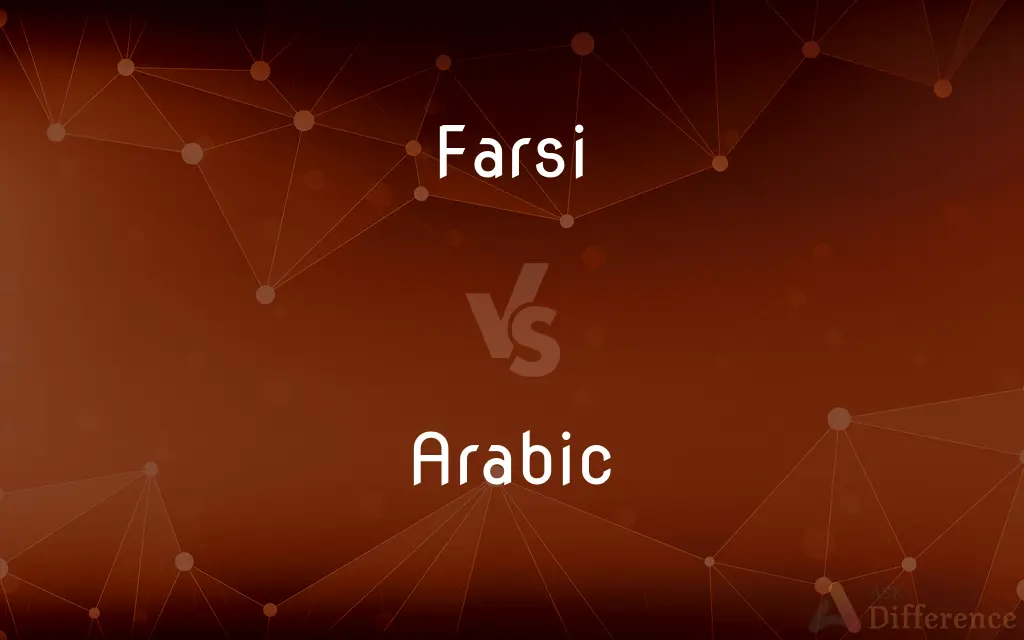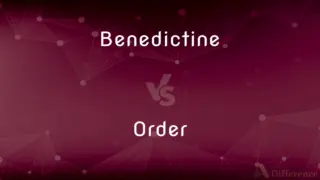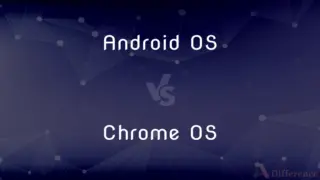Farsi vs. Arabic — What's the Difference?
By Tayyaba Rehman & Maham Liaqat — Updated on April 1, 2024
Farsi, spoken in Iran, Afghanistan, & Tajikistan, uses modified Arabic script, focusing on poetic & literary expression. Arabic, with its many dialects, is liturgical language of Islam, emphasizing religious texts and communication across the Middle East.

Difference Between Farsi and Arabic
Table of Contents
ADVERTISEMENT
Key Differences
Farsi, also known as Persian, is the primary language of Iran and is written in a script derived from Arabic, with additional characters to accommodate Persian sounds. Whereas Arabic is used in a wide range of countries across the Middle East and North Africa and is known for its variety of dialects, reflecting regional differences.
Farsi speakers often find learning Arabic script relatively straightforward due to the similarities, but the languages diverge significantly in grammar, vocabulary, and pronunciation. On the other hand, Arabic learners may struggle with Farsi’s unique phonetics and the presence of many loanwords from other languages.
In terms of literature, Farsi is renowned for its rich heritage in poetry and prose, dating back over a thousand years. Whereas Arabic literature is also vast and varied, with deep roots in poetry, religious texts, and philosophical writings, reflecting its role as the language of the Quran.
Farsi incorporates a significant number of loanwords from languages such as French, Russian, and English, particularly in modern and scientific discourse. Arabic, while also absorbing foreign words, has a strong tendency towards Arabization of terms, maintaining a closer alignment with classical forms.
The cultural impact of Farsi is strongly felt in the realms of Persian poetry and the historical influence of the Persian Empire, emphasizing cultural and artistic achievements. Arabic culture, by contrast, is deeply intertwined with the Islamic religion, influencing art, music, and daily life across multiple continents.
ADVERTISEMENT
Comparison Chart
Alphabet
Uses a modified Arabic script with additional letters
Original Arabic script
Geographic Distribution
Primarily Iran, Afghanistan, and Tajikistan
Middle East, North Africa, and widely studied globally
Dialects
Fewer regional dialects
Numerous dialects with significant variation
Cultural Influence
Rich in poetry and literature
Strong religious influence through Islam
Loanwords
Incorporates many from French, Russian, English
Prefers Arabization of foreign terms
Compare with Definitions
Farsi
Farsi is the main language of Iran.
Farsi is taught in Iranian schools as the national language.
Arabic
The Quran is written in Arabic.
Muslims around the world learn Arabic to understand the Quran.
Farsi
Farsi is known for its poetic tradition.
The works of Hafez are celebrated examples of Farsi literature.
Arabic
Arabic script is used by several languages.
Arabic calligraphy is an art form in its own right.
Farsi
It uses a script derived from Arabic.
Reading Farsi requires learning its modified Arabic alphabet.
Arabic
Regional variations are significant.
Egyptian Arabic is vastly different from Moroccan Arabic.
Farsi
Incorporates foreign words easily.
Modern Farsi includes English words like computer.
Arabic
Arabic often Arabizes them.
The Arabic term for telephone is hatif, derived from classical roots.
Farsi
Unique sounds not found in Arabic.
Farsi pronunciation includes sounds unfamiliar to Arabic speakers.
Arabic
Arabic is a Semitic language with many dialects.
Modern Standard Arabic is used in formal settings across the Arab world.
Farsi
The modern form of the Persian language, especially the western dialect of Persian that is the national language of Iran.
Arabic
Arabic (اَلْعَرَبِيَّةُ, al-ʿarabiyyah [al ʕaraˈbijːa] (listen) or عَرَبِيّ, ʿarabīy [ˈʕarabiː] (listen) or [ʕaraˈbij]) is a Semitic language that first emerged in the 1st to 4th centuries CE. It is now the lingua franca of the Arab world. It is named after the Arabs, a term initially used to describe peoples living in the Arabian Peninsula bounded by eastern Egypt in the west, Mesopotamia in the east, and the Anti-Lebanon mountains and Northern Syria in the north, as perceived by ancient Greek geographers.
Farsi
A person of Iranian descent;
Many Farsi emigrated to India near Bombay
Arabic
A Semitic language originating in the Arabian Peninsula that since the 7th century AD has come to be the principal language of a wide area of the Middle East and North Africa. Modern spoken Arabic consists of many different, often mutually unintelligible dialects, and a modified form of classical Arabic is used as the language of education and administration across the area.
Farsi
The language of Persia (Iran) in any of its ancient forms
Arabic
Of or relating to Arabia, the Arabs, their language, or their culture.
Arabic
(rare) gum arabic
Arabic
Of or pertaining to Arabia or the Arabians.
Arabic
The language of the Arabians.
Arabic
The Semitic language of the Arabs; spoken in a variety of dialects
Arabic
Relating to or characteristic of Arabs;
Arabic languages
Common Curiosities
Can Farsi speakers understand Arabic easily?
Not necessarily; despite script similarities, the languages differ significantly in grammar, vocabulary, and pronunciation.
What makes Farsi literature unique?
Farsi literature is renowned for its extensive poetic and prose works, reflecting the language’s rich cultural heritage.
How are Farsi and Arabic scripts related?
Farsi uses a script derived from Arabic, but with additional characters to accommodate Persian sounds.
What is Farsi?
Farsi, or Persian, is the main language of Iran, characterized by its use of the Arabic script with modifications.
What is Arabic?
Arabic is a Semitic language widely used across the Middle East and North Africa, known for its many regional dialects.
Can learning Farsi help with understanding Arabic culture?
While it provides some insights, the significant linguistic and cultural differences between Farsi and Arabic cultures mean learning Arabic is essential for a deeper understanding.
How does Arabic influence religion?
Arabic is the liturgical language of Islam, deeply influencing religious practices and texts.
Are there many dialects in Farsi?
Farsi has fewer regional dialects compared to Arabic, which has a wide range of dialectical variations.
What’s the global significance of Arabic?
Arabic is one of the six official languages of the United Nations, reflecting its global importance in diplomacy and international relations.
What role does Arabic play in education?
Arabic is crucial for religious education in Muslim countries and is often taught globally for scholarly and diplomatic reasons.
How do Farsi and Arabic handle loanwords?
Farsi readily incorporates foreign loanwords, while Arabic tends to Arabize them, aligning new terms with traditional language structures.
Is Farsi similar to any other languages?
Farsi shares some similarities with other Indo-European languages, differing significantly from Semitic languages like Arabic.
How does the Arabic script impact the visual arts?
Arabic calligraphy is a highly regarded art form, influencing Islamic art and design worldwide.
What’s the significance of Arabic in art and culture?
Arabic has a significant impact on Islamic art, music, and architecture, reflecting its cultural and religious importance.
How important is pronunciation in Farsi and Arabic?
Pronunciation is key in both languages, with unique phonetic qualities that can change meaning significantly.
Share Your Discovery

Previous Comparison
Benedictine vs. Order
Next Comparison
Bulling vs. BullyingAuthor Spotlight
Written by
Tayyaba RehmanTayyaba Rehman is a distinguished writer, currently serving as a primary contributor to askdifference.com. As a researcher in semantics and etymology, Tayyaba's passion for the complexity of languages and their distinctions has found a perfect home on the platform. Tayyaba delves into the intricacies of language, distinguishing between commonly confused words and phrases, thereby providing clarity for readers worldwide.
Co-written by
Maham Liaqat














































